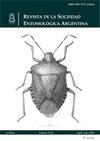阿根廷门多萨山区沙漠有机葡萄园中切叶蚁的觅食和巢维持活动
IF 0.5
4区 农林科学
Q4 ENTOMOLOGY
引用次数: 1
摘要
切叶蚁只存在于新热带地区,被认为是农业害虫,尽管它们对植物也有积极的影响。在门多萨(Mendoza)的葡萄园,植物的生物多样性极低,因此他们切断了这种植物作为食物来源。它主要是夜行动物,根据温度觅食。从2019年10月到2020年3月,每月测量14个殖民地的觅食和维持活动,每隔4小时一整天。红角顶蛾的觅食活动表现出不同的季节特征。1、2月采食强度最高,12月中等,10、11月最低。双峰取食模式,白天和夜间都觅食,避开最热的时段。在10 - 19°C范围内观察到最多的碎片收集,在20 - 39°C之间较少,在40 - 49°C之间最小,在0 - 9°C之间为零。巢维持活性在20 - 29°C之间最大,在30 - 39°C之间最小,在40 - 49°C之间最小,在0 - 20°C之间为零。本文章由计算机程序翻译,如有差异,请以英文原文为准。
Foraging and nest maintenance activity of the leafcutter ant Acromyrmex lobicornis (Hymenoptera: Formicidae) in an organic vineyard in the Monte desert of Mendoza, Argentina
Exclusive to the Neotropical region, leaf cutter ants are considered agricultural pests, although they can also have a positive effect on plants. In Mendoza vineyards, vegetal biodiversity is minimal, therefore they cut off this plant as a feeding resource. Acromyrmex lobicornis Emery it is mostly nocturnal and forages according to temperature. Foraging and maintenance activity was measured monthly in 14 colonies, throughout a full day at fourhour intervals, from October 2019 to March 2020. Acromyrmex lobicornis showed different seasonal patterns of foraging activity. Foraging intensity was highest throughout January and February, intermediate during December, and lowest in October and November. A bimodal feeding pattern was observed, foraging both day and night avoiding the hottest hours. The maximum collection of fragments was observed in the range of 10 and 19 °C, less between 20 - 39 °C, minimum between 40 - 49 °C and null between 0 - 9 °C. The nest - maintenance activity was maximum between 20 - 29 °C, less between 30 - 39 ° C, minimum between 40 - 49 °C and null between 0 - 20 °C.
求助全文
通过发布文献求助,成功后即可免费获取论文全文。
去求助
来源期刊

Revista De La Sociedad Entomologica Argentina
Agricultural and Biological Sciences-Insect Science
CiteScore
0.80
自引率
20.00%
发文量
31
审稿时长
20 weeks
 求助内容:
求助内容: 应助结果提醒方式:
应助结果提醒方式:


